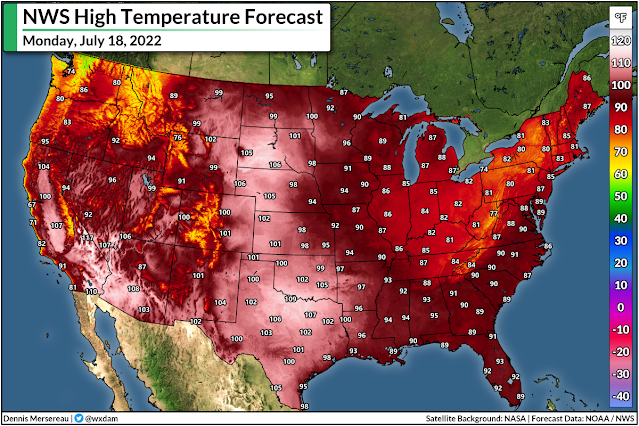There's a hot summer day and a dang hot summer day. A spell of extreme heat on the southern Plains is set to get worse over the next couple of days as high temperature crank well above the 100-degree mark for much of the region. Highs will easily climb above 110°F for some areas, especially in Oklahoma.
A strong ridge of high pressure building over the western two-thirds of the United States will focus its ire on the southern Plains as we begin the workweek. It's already been pretty darn hot month across the region so far. 12 of the past 16 days at Dallas-Fort Worth Int'l Airport have clocked in at 100°F or hotter so far this month, and that pattern looks to continue as we head into the new week.
The worst of the heat will build on Monday, Tuesday, and Wednesday. The National Weather Service's latest forecast calls for high temperatures to exceed 105°F
Here are the NWS's predicted highs for Monday, July 18th...
...Tuesday, July 19th...
...and Wednesday, July 20th.
That's brutal heat for anyone. It's going to be exceptionally rough on vulnerable populations such as the elderly, low-income families who don't have adequate (or any) access to air conditioning or fans, folks battling illnesses, and those who have to work outside for long periods of time.
What's going to make the heat even harder is that it's not going to cool off much at night. Tuesday is going to be the hottest day across the region, and nighttime temperatures are going to struggle to fall below 80°F in spots, especially in Oklahoma.
Here's the National Weather Service's predicted low temperatures for Wednesday morning:
That's a morning low of 86°F in Tulsa. Ouch.
Extreme heat is a compounding risk. Each day of excessively hot temperatures bleeds into the next, without much relief at night, adding stress to vulnerable populations until it becomes too much to bear.
Heat exhaustion is no joke. It can sneak up on you in a hurry if you're not careful. Drink more water than you think you need to drink. Don't push it in the hot sunshine. Find ways to stay cool if you don't have adequate cooling. Check on your neighbors if you know they might have a hard time with the heat.
 |
| SOURCE: CDC |
The ridge will start to break down a bit as we head later into the week, but broad ridging over the central United States will keep temperatures at or above the century mark for the southern Plains at least through next weekend. This is going to be a rough stretch of hot weather the likes of which this region hasn't seen in a long while.
You can follow me on Twitter or send me an email.
Please consider subscribing to my Patreon. Your support helps me write engaging, hype-free weather coverage—no fretting over ad revenue, no chasing viral clicks. Just the weather.
Please consider subscribing to my Patreon. Your support helps me write engaging, hype-free weather coverage—no fretting over ad revenue, no chasing viral clicks. Just the weather.














